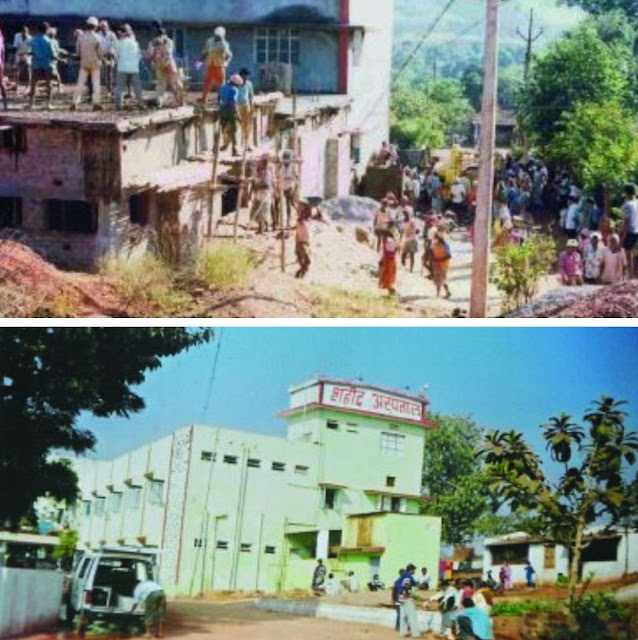
At a time when the trend of trying to maximize profits has led to so many serious distortions in the health sector, the need for at least some efforts which have been consistently providing rationality based, low cost medical care with a special emphasis on trying to reach out to workers and peasants and to all weaker sections of society has increased further.
The Shaheed Hospital in Dalli Rajhara (Chattisgarh) region provides one such highly inspiring example. It is, moreover, a very rare example of a hospital which was actually created, built, expanded by workers, using their own hard labor and meager savings (with some help from other well-wishers). It has been a tremendous effort to maintain the continuity of this hospital’s work during the last four decades.
The Shaheed Hospital also provides a very inspiring example of many deeply committed doctors, nurses, medical and other workers who have been serving the hospital with the deepest commitment over the years.
In particular one must mention Dr. Saibal Jana who has been with the hospital since its birth and still continues to lead this inspiring effort, braving many difficulties and adversities.
Going back about four decades, the late seventies and early eighties were a period of great awakening and hope in the mining township of Dalli Rajhara. The iron ore miners, particularly contract workers, had been successfully resisting highly exploitative practices including very low wages.
Under the inspiring leadership of the legendary trade union leader Shankar Guha Niyogi and his close colleagues, the workers had followed this success with many constructive programs with the understanding of combining struggles with many-sided constructive work (sangharsh va nirman).
This included a very effective campaign against liquor addiction, education and vocational training, cultural programmes and above all a strong health program of workers and peasants.
By then the trade union had spread to some other mining areas as well and what is more, had established a strong organizational base in the rural areas under the banner of Chhattisgarh Mukti Morcha (CMM). This and the main trade union called the Chattisgarh Mines Shramik Sangh (CMSS) became the main hub of asserting the rights of workers and peasants in this region.
I was fortunate to be a part of these times of hope as a visiting reporter and journalist. However my first visit to the area was in more difficult circumstances, as a member of a human rights team, when a big protest movement was going on and Niyogi Ji had been arrested. Later I also got permission to meet Niyogi Ji in jail.
So phases of repression and the resulting protests were always coming in and the constructive work had to be continued in the middle of this. Niyogi Ji once told with a sigh — we have so many ideas about experimental constructive work with great potential but the day to day problems which are always being created for our union leaves us very less time for this.
Despite this, constructive work like workers giving up liquor on a large scale and in a very determined way was a big success. Around the same time as visitors we started seeing patients coming in significant numbers to a dispensary operating then from a garage. Doctors like Vinayak Sen, Ashish Kundu and Saibal Jana had started reaching here to start a healthcare program, and a health committee of workers had been formed.
At the time of disasters like Latur earthquake and Bhopal gas leak, the hospital sent its volunteers for helping
The arrangement in garage was only a temporary one, we learnt, the workers plan to soon build their own hospital! This was great news which enthused many visitors, but they had their doubts too. A hospital, its building and equipment cost a lot of money too; how can the workers arrange all this.
But soon the workers by their strong determination were soon turning this into a reality. As many as 1000 workers would gather at the time of construction and with their disciplined and dedicated voluntary work would complete in a single day work that may otherwise drag on for an extended period.
During subsequent visits visitors saw the inauguration of the new hospital building in 1983, additions to it, various equipment and new facilities being added, an ambulance being purchased, the number of beds being increased.
Each of these improvements and additions was a quiet celebration of the aspirations of the workers and peasants, most of them from tribal communities and other weaker sections who had suffered much due to earlier denial of proper medical care and some had even lost family members due to this.
The hospital got its name Shaheed (martyr) from the memory of those comrades who had been killed in the course of an early struggle; they would surely rest in peace that an institution created in their name has saved so many precious human lives.
Even at an early stage the hospital and the union took steps to take health campaigns to wider rural areas and improve water and sanitation in the area. At the time of disasters like the Latur earthquake and the Bhopal Gas Leak disaster, the hospital sent its volunteers for helping.
Young doctors and health personnel keen to work with similar ideals came here to gain experience and inspiration. The hospital became a center recognized widely for providing very good training to nurses. It contributed to and also made made effective use of various government health programs.
As the hospital completes nearly 4 decades of its tremendously useful and inspiring efforts, There are many, many friends and beneficiaries who wish for the further success of this effort, with more doctors and others coming forward to help.
*Honorary convener, Campaign to Save Earth Now. His recent books include ‘Planet in Peril’, ‘A Day in 2071’ and ‘Man over Machine’
Courtesy: https://www.counterview.net